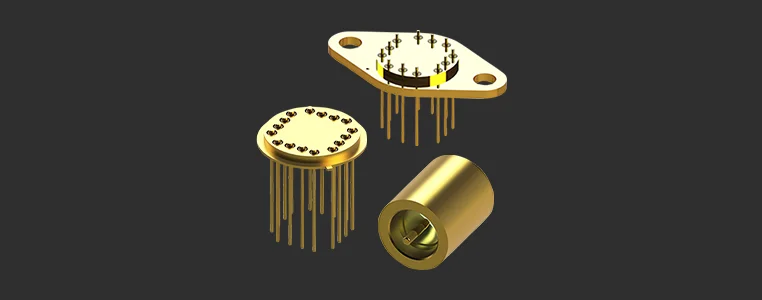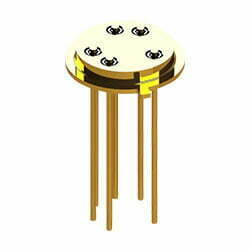
Glass-to-Metal Seals
A glass-to-metal seal is the fusion between glass, an electrical conducting wire, and metal case to create a feedthrough or passthrough. Glass (originally borosilicate glass) is used as an insulator to bond the metal housing as well as the pin through a controlled, high-temperature heating process. As the part is heated, the glass beads or engineered preform flow into the cavity to seal the connection point. In certain applications, a surface treatment or plating can be applied to increase corrosion resistance and to enable a variety of assembly processes.
Glass-to-metal seals are suitable for high temperatures, high pressures, and harsh conditions such as shock, vibration, and chemical exposure. They are a trusted component from consumer devices to high-technology satellite systems, creating a leak-tight hermetic seal between two areas. These types of hermetic seals can also be produced in high volumes for OEM applications such as sensors, battery lids, and optical lids.
EPI focuses on creating glass-to-metal hermetic seals for microelectronic packages. This includes standard transistor outline (TO) headers and packages as well as custom feedthrough designs.
EPI not only offers our HTCC ceramic technology as a compliment to glass-to-metal sealing, but can design and manufacture hybrid hermetic packages combining the technologies to create unique solutions to solve challenging conditions. Epoxy-based feedthroughs are also possible to combine with glass-to-metal seal technology, creating cost-effective hermetic assemblies for power and signal applications.

PRODUCTS USING GTMS TECHNOLOGY
Types of Glass-to-Metal Seals
COMPRESSION SEALS
When processing a compression seal, the housing contracts around the glass due to its differing coefficient of thermal expansion (CTE) to make a hermetic seal.
- Typically stronger than matched seal designs with greater chemical compatibility potential; increased pressure ratings
- Common feedthrough materials include stainless steel and titanium
- Common glass materials include soda lime and alkali barium
MATCHED SEALS
As the name states, the housing of a matched hermetic seal matches the coefficient of thermal expansion of the glass during the firing process.
- Withstands higher differential temperatures between sides of the feedthroughs because of lower thermal cycle stress.
- Typical seal material is Kovar* (nickel-cobalt alloy)
- Typical glass materials include Borosilicate, Alkali Barium, vitreous silica glass
Other Hermetic Sealing Technologies
HIGH-TEMPERATURE CO-FIRED CERAMIC (HTCC)
Electronic Products (EPI) is a powder-to-package, fully integrated HTCC technical ceramics package manufacturer. Learn about our high-temperature, multilayer circuit capabilities using ceramic seal technology.

HERMETIC EPOXY
Douglas Electrical Components manufactures hermetic feedthroughs and connectors using a low-outgassing, chemically inert epoxy to create high-density custom feedthroughs.
Unsure Where to Start?
Let’s Connect
Our team takes pride on the ability to provide technical support across a variety of applications. Tell us about your hermetic package requirements and we’ll work to find a solution together. We’re ready for the challenge.
